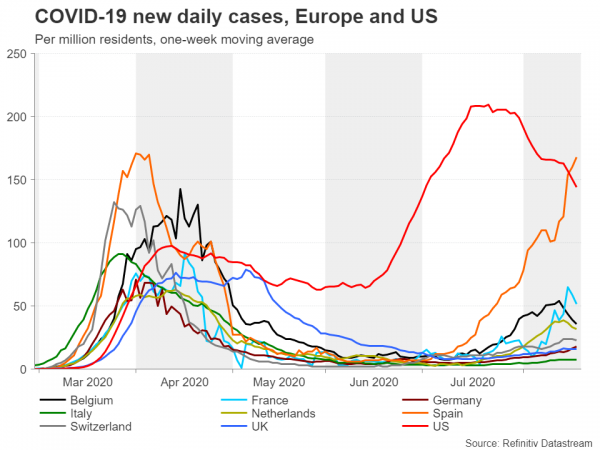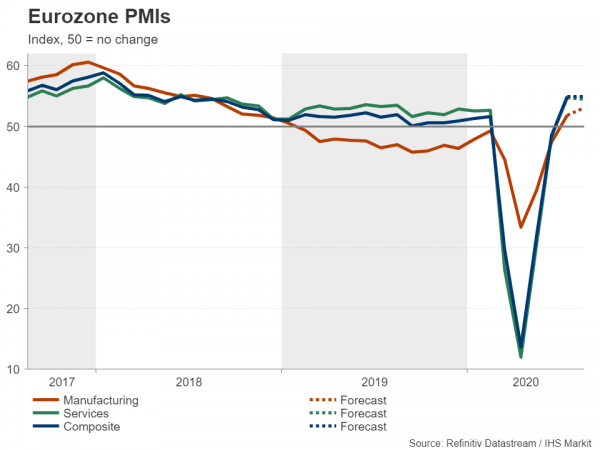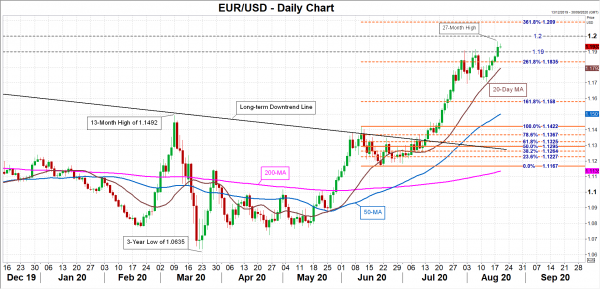The flash PMI readings for August will be the sole economic highlight for the euro area this week as investors try to get a better sense of where Europe’s recovery is headed amid a spike in coronavirus cases over the summer. The data, due at 08:00 GMT on Friday, might point to the recovery losing some steam in the past couple of weeks as businesses face challenging trading conditions. However, unless the PMIs widely undershoot expectations, the euro will likely maintain its upward charge against the faltering US dollar.
European recovery faces new virus threat
It’s been so far so V for Europe’s climb out of the pandemic slump. The closely watched Purchasing Managers’ Index (PMI) reports by IHS Markit are indicating a strong rebound in the third quarter after a record collapse in GDP in the second quarter. Higher confidence in the ability of European leaders to manage both the health crisis and the ensuing economic shock compared to other regions has cast the euro under a more attractive light. That, combined with the broad dollar selloff, has put an end to the euro’s protracted downtrend once and for all.
However, as the single currency approaches the psychologically important $1.20 level for the first time in more than two years, Europe may be losing its virus and economic edge over the United States. The easing of lockdown restrictions across the continent has led to a jump in new COVID-19 cases in most Eurozone countries, with the summer tourism season exacerbating the spread. Although, so far, authorities have only announced limited new restrictions to enforce social distancing, a continued acceleration in the infection rate could necessitate tougher measures. Signs that the virus resurgence in the US is not only slowing but didn’t significantly hurt the recovery pose another question mark for the euro/dollar rally.
Can PMIs stay on a V-path?
That makes it all the more important for the Eurozone recovery to prove sustainable if the euro is to maintain its bullish posture. However, those hoping to see a faster bounce in business activity in August may get disappointed. The Eurozone composite PMI is forecast to stay unchanged at 54.9, which – while that would still signal a healthy growth rate – wouldn’t go far enough to compensate for the steep plunge posted in Spring.
A moderation in services activity is likely to be the main drag on the composite reading. The services PMI is expected to slip from 54.7 to 54.5 in August. But the manufacturing PMI might provide a bright spot as it is forecast to jump from 51.8 to 52.9.
Euro rally eyes $1.20
If the PMI numbers are more or less in line with expectations or better, investors will probably stick with their existing views of the Eurozone outlook and continue to push the euro higher. Having just beaten the previous obstacle at the $1.19 mark, the next challenge for the euro bulls is the $1.20 target. Above that, buyers might meet resistance at the 361.8% Fibonacci extension of the June down leg at $1.2090.
But in the event of a negative surprise in the data, euro/dollar could reverse lower, with the 20-day moving average potentially being the first point of call just above $1.1790. A sharper correction could pull the pair all the way down to the 161.8% Fibonacci extension of $1.1580.
Bumps ahead
Beyond this week’s PMI data, a key factor to watch will be whether Eurozone governments will consider shutting down parts of the economy again to control what is increasingly looking like a second wave of the virus, and how this will influence policy at the European Central Bank. But even if a full blown second outbreak can be avoided, there’s a high risk the recovery stalls over the coming months amid the realization that there’s a limit to how far business life can return to normal during a global pandemic. A stronger exchange rate could also create headaches for the euro bloc as it would make exports more expensive, further straining the recovery.
















